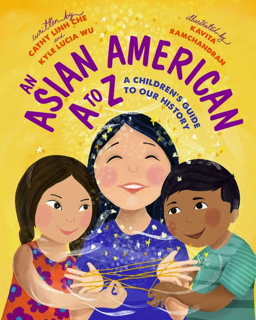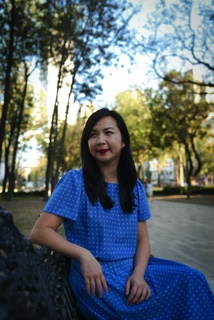Cathy Linh Che is the co-author (with Kyle Lucia Wu) of the children’s book An Asian American A to Z: A Children’s Guide to Our History. She is interviewed here by APALA member Anastasia Chiu.
Anastasia Chiu (AC): Please introduce yourself and briefly describe your literary work and career path to date.
Cathy Linh Che (CLC): I’m Cathy Linh Che, and I’m the author of a poetry book Split and co-author of the children’s book An Asian American A to Z: A Children’s Guide to Our History. I’m also working on another poetry collection, a memoir, and documentary about my parents’ experiences as Vietnam War refugees playing extras on Francis Ford Coppola’s war epic Apocalypse Now. Though I’d always loved reading and writing, I never imagined that I’d publish a book or live a life as an artist. Instead my love of language led me to become a high school English teacher, a rewarding but exhausting job. I left teaching high school English at Bell High School in order to pursue an MFA in Creative Writing at New York University. There, the possibility of writing books became real to me—and set me on a path toward becoming an author.
AC: As a leader of Kundiman, an organization that supports the cultivation of Asian American writing, I know that you often engage in conversations about personal identity in writing. Can you tell us a little about how your identity influences your writing? Your readership?
CLC: My work life and my creative life intersect and overlap in so many ways—it is difficult for me to separate the two. In the same way, I don’t know how to separate my personal identity from my writing. I’m a Vietnamese American daughter of refugees from Los Angeles who has grappled with my parents’ stories of their lives during and after the Vietnam War, as well as my own experiences with sexual violation. These experiences have shaped who I am as a person, and I write these narratives because they haven’t been represented adequately in literature. When I write, the primary audience I have in mind are those who occupy similar aspects of my personal identity, people who haven’t had the opportunity to see themselves reflected in books. But my readership has ended up being much broader than that. People of many different experiences have connected with my writing, and this has also been richly rewarding—and wonderfully unexpected.

AC: What led you into the children’s literature space with your new book, An Asian American A to Z?
CLC: My work at Kundiman led me toward learning more about Asian American history, and much of what I’d learned was completely unknown to me until well into my 30s. I knew I was not alone in this knowledge gap.
And, so, I wanted to write a book that I wish I would have had when I was a child, something that would allow me to know more about my place within American history.
This teaching was absent throughout my formal education, and the book felt like a way to create a different kind of future for the next generation. I know that not everyone gets to work within Asian American spaces, and I wanted to be able to offer up what I’d learned along the way in a format that was informative, exciting, and rhythmic.
AC: You mention and describe many progressive movements and figures in Asian American history that I wish I had known about as a young person! How did you choose each of the moments, figures, and facets of Asian American history and life that you portrayed in An Asian American A to Z?
CLC: I am excited to be able to educate people about Asian American activism and solidarity. I wanted to provide a grounding in our origin story, as well as the names of key activists and historical moments that shape Asian America.
I gathered much of my learning from the history texts available to me. My co-author Kyle [Lucia Wu] loaned me a copy of Erika Lee’s The Making of Asian America: A History, which did a brilliant job of explicating 400 years of Asian American history within only 560 pages. I also read Karen L. Ishizuka’s Serve the People: Making Asian America in the Long Sixties, a powerful oral history of the Asian American Movement’s formation. At the Kundiman Retreat and at our Youth Leadership Intensives, we have hosted Asian American Literature and History sessions, led by Timothy Yu and Ryan Lee Wong, and they were important in teaching many of these facts and facets of Asian American history. Many of these histories will more prominently feature Chinese, Japanese, and Filipino histories, as these groups formed some of the larger groups early on in America. As a Vietnamese American, I had extensive knowledge of my own history, having heard my parents’ stories, having taken Vietnam War courses in college, and having read and written Vietnam War literature. Our work at Kundiman also informs the way that we think about representation within Asian American spaces and the importance of thoughtful curation—and gives us strong connections to different communities who can give us support. As an additional measure, my co-author Kyle and I reached out to additional readers who were able to teach us more about South Asian, Pacific Islander, and West Asian histories. We hope that, together, we wrote something that reflected our shared learning and values while also leaving openness for an ever-evolving Asian American history.
AC: We’re always looking for more to read. Who are five authors we should be reading?
CLC: Here are five children’s book authors and illustrators who I recommend!
Thi Bui
Rio Cortez
Bao Phi
Terisa Siagatonu
Jess X. Snow
AC: You’re being interviewed by a librarian, for an audience of Asian American and Pacific Islander librarians. What are your thoughts on libraries, and their place in building diverse communities?
CLC: I love libraries! I grew up in a library in Highland Park, CA, which was a place that was home to many Mexican, Vietnamese, Salvadoran, and Chinese immigrants, and when I moved to Long Beach, the library was a place also for the Cambodian and Pacific Islander communities around me.
My libraries fostered in me a love of reading and a sense of magic.
Libraries are wonderful homes for so many book lovers everywhere. I love the classes and story times and public offerings provided by libraries everywhere—and I’m thrilled to be able to provide this book to the libraries that raised me as a young person!
AC: What advice would you give young professionals, especially those from racially marginalized backgrounds, who are interested in a career in writing?
CLC: I’d say, Go for it! Your voice is powerful and necessary.
However, I think of writing as more of a calling than a career. Though it doesn’t promise the easiest pathway, writing, publishing, and sharing have been richly rewarding to me. I believe that writing into silence has the ability to affect change, both intimate and global, and I want to write truths that make people feel less alone.
In the same vein, I want to encourage everyone who comes from a racially marginalized background to follow your dream! Your readers are out there waiting for you.
Interview by Anastasia Chiu with editing support by Amanda Cheung.
Book reviews and author interviews featured on APALAweb.org are reflective of the reviewer and interviewer only and are conducted separately from and independently of APALA and the APALA Literature Awards Committee and juries.

